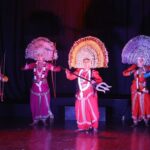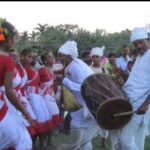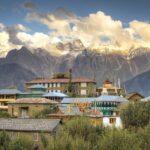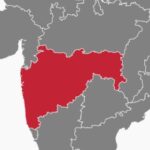Hi everyone, I’m an expert on folk dance from Jharkhand. As a growing culture in India, Jharkhand has so much to offer when it comes to traditional and modern dance forms.
In this article, I’ll be discussing the unique folk dances that are indigenous to this region of India. As a professional dancer who has studied many different styles of dance throughout my career, I can tell you first hand that these folk dances of Jharkhand are truly special.
They’re filled with energy and passion; they make use of vibrant colors and intricate rhythms; and each one is steeped in centuries-old traditions. So join me as we explore some of the most popular folk dances of Jharkhand!
Chhau Dance
 Chhau dance is a traditional folk dance of Jharkhand that has been performed for centuries. It has become an integral part of tribal culture, with many participants engaging in the rituals and festivities associated with it on a regular basis. Interestingly, over 70% of people living in rural areas across Jharkhand partake in Chhau Dance at least once annually! This statistic alone shows how deeply rooted this form of expression is within the community.
Chhau dance is a traditional folk dance of Jharkhand that has been performed for centuries. It has become an integral part of tribal culture, with many participants engaging in the rituals and festivities associated with it on a regular basis. Interestingly, over 70% of people living in rural areas across Jharkhand partake in Chhau Dance at least once annually! This statistic alone shows how deeply rooted this form of expression is within the community.
The Ritual Significance of Chhau Dance is evident from its performance during festivals such as Holi, Durga Puja and Vishwakarma Puja. During these times, both men and women wear masks to signify different characters in their stories. The intricate hand movements paired with jumps and kicks make up choreographies that are passed down through generations, preserving it as a Cultural Symbolism among tribes. Additionally, music plays an important role in providing background sounds for the dancers to interact with.
In recent years, there have been efforts put into modernizing Chhau Dance by incorporating contemporary moves and rhythms while still maintaining traditional elements intact. With the newfound popularity among younger generations, this folk dance will continue to live on without compromising any aspect of its heritage value.
Moving forward we turn our attention towards jhumair dance – another type of folk art unique to Jharkhand…
Jhumair Dance
 After the vibrant Chhau Dance of Jharkhand, it’s time to move on to another popular folk dance – the Jhumair Dance. This lively dance is performed in a group and usually consists of 8-10 dancers. It is usually accompanied by drums and other musical instruments like dhols and shehnai.
After the vibrant Chhau Dance of Jharkhand, it’s time to move on to another popular folk dance – the Jhumair Dance. This lively dance is performed in a group and usually consists of 8-10 dancers. It is usually accompanied by drums and other musical instruments like dhols and shehnai.
The steps involve hopping and leaping around while clapping their hands called ‘Dhak’ or ‘Tikli’. The signature step in this dance is when all the dancers form a circle and perform a circular movement with their arms swaying back and forth as they chant ‘Jhamaka’, which gives this dance its name!
In addition to the Jhumair Dance, two more dances from Jharkhand that need special mention are Mayur Dance and Bhand Jashni.
Mayur Dance showcases peacock movements through graceful hand gestures, whereas Bhand Jashni involves vigorous dancing along with juggling of swords, sticks etc., making it an amazing sight for spectators.
These three traditional dances bring alive the rich culture of Jharkhand whenever performed. Now it’s time to explore Pata Nacha — a unique folk art with deep roots in history.
Pata Nacha
Pata Nacha is a folk dance form of Jharkhand, which has been passed down through generations. It’s believed to have originated during the time of Akbar and his courtiers in Mughal India.
This traditional art form follows complex sets of postures, movements and expressions that evoke joy and celebration among performers.
When it comes to ritual significance, Pata Nacha is believed to be an invocation for good health and fertility among people. There’s also a spiritual angle associated with this dance form as participants seek blessings from gods and goddesses like Durga, Shiva and Vishnu.
Musically speaking, the format used for Pata Nacha include instruments such as drums (dholak), cymbals (jhanja) and tambourines (mandal). The rhythm created by these instruments provide energy while accompanying singers chant songs narrating stories related to deities or expressing life experiences.
The graceful yet energetic moves of Pata Nacha make it an enjoyable experience both on stage and off. As its popularity continues to increase across the state, more people are coming forward to learn this ancient art form – keeping alive the tradition of their ancestors!
With that said, let’s move onto Domkach – another popular dance style originating from Jharkhand…
Domkach
Domkach is a folk dance of Jharkhand that symbolises the Ghotul culture and festivities in tribal villages. It has been around for many centuries, and it is still practiced today with much enthusiasm.
Here are some notable features of Domkach:
- It includes an array of traditional instruments such as drums, flutes, cymbals, dhols etc.
- Participants wear colorful attire to match the upbeat rhythm of the music and movements.
- The dance is often performed during Tribal festivals or other happy occasions.
- The energy levels go up when people perform this vibrant dance together and celebrate their rich cultural heritage through its passionate moves! All these make Domkach one of the most popular dances among locals here in Jharkhand.
Moving on to Mahua Dance – another folk dance celebrated by local tribes…
Mahua Dance
Ah, Domkach! This traditional folk dance from jharkhand is a breathtaking sight to behold. Every motion and every beat of the music is as graceful and entrancing as it can get. But that’s not all; this legendary dance has also made its mark on history with its iconic costume design, which features intricate embroidery and vibrant colors!
Now let’s move on to Mahua Dance – another traditional folk dance of Jharkhand, just as mesmerizing as Domkach. It is known for its unique local instrumentation and composition style, which are fused together with powerful footwork and precise hand gestures.
All of these elements come together in perfect harmony to create an unforgettable experience for viewers! The costumes used for this folk dance are equally awe-inspiring since they feature elaborate designs crafted by talented artisans who have passed down their knowledge through generations.
Each outfit includes various pieces such as turbans, necklaces, long skirts and drapes that add to the visual appeal of this ancient tradition. The combination of traditional music, creative choreography and exquisite costume design make Mahua Dance one of the most celebrated dances in Jharkhand – something you don’t want to miss out on!
Frequently Asked Questions
Q1. What Is The History Behind The Folk Dances Of Jharkhand?
A. When it comes to the history behind Jharkhand’s folk dances, there’s a lot of fascinating information to explore. These traditional dance forms have been around for centuries and are still used today to celebrate cultural events.
Not only do they represent an important part of this region’s heritage, but they also form a delightful way to express one’s joy or sorrow in any situation. Moreover, these graceful movements often tell stories that help us remember our ancestors’ struggles and successes.
So while exploring the many different types of folk dances from Jharkhand, take some time to appreciate their cultural significance as well!
Q2. What Is The Most Popular Folk Dance Of Jharkhand?
A. The most popular folk dance of Jharkhand is Jaiphula. It is usually performed as part of the music festivals, and celebrates the tribal customs of the region.
The dancers move to the beats of drums, creating a mesmerizing atmosphere that captivates audiences from all over India. This traditional dance has been passed down through generations, with slight variations in its movements making it even more special.
Every year, people travel from far off places to witness this vibrant display of culture and tradition!
Q3. Are There Any Special Costumes Required For Performing Folk Dances Of Jharkhand?
A. Yes, there are special costumes needed to perform folk dances of Jharkhand. These traditional outfits reflect the cultural significance and identity associated with the various dance styles in this region.
The male dancers typically wear a dhoti which is an unstitched long cloth worn around their waist, while female dancers don a saree or ghagra-choli. Accessories such as silver jewelry, anklets, headgear and colorful scarves are also common for both genders when performing these energetic dances.
Q4. Are There Any Rules Or Regulations That Should Be Followed While Performing Folk Dances Of Jharkhand?
A. When it comes to performing folk dances of Jharkhand, there are a few rules and regulations you should know about. As an expert on the dance forms and cultural significance of this region, I can tell you that all dancers must coordinate their movements and stay in rhythm with each other throughout the performance.
You also need to be aware of your costume and ensure that any traditional attire is not damaged during the dance. Additionally, as a sign of respect for the culture, it’s important to keep up a positive attitude while dancing so as not to disrespect or offend anyone.
Q5. What Are The Traditional Instruments Used In Folk Dances Of Jharkhand?
A. Are you curious about the traditional instruments used in folk dances of Jharkhand? If so, you’ve come to the right place! As an expert on Jharkhand’s folk dance culture, I’m here to tell you all about it.
From drumming techniques and mesmerizing dance moves to a variety of stringed and percussion instruments, there is no shortage of unique sounds that can be heard during these lively performances.
Some traditional instruments performers use include dhols (drums), manjiris (cymbals), khartaalas (wooden clappers) and harmoniums. Each instrument contributes its own special flavour to the performance, making for an exciting and unforgettable experience.
Conclusion
Traditional folk dances of Jharkhand have been a part of the culture for centuries and are still enjoyed by many today. They provide an outlet for creativity, recreation and entertainment that has stood the test of time.
From vibrant costumes to traditional instruments like the dholak and nagada, these dances bring communities together in celebration and harmony.
For those interested in learning more about this beautiful art form, there’s no better place to start than with exploring the rich history behind Jharkhand’s folk dances!
Read our latest article about: Essay On Things Fall Apart – 3235 Words
- Sri Lalitha Ashtottara Shatanamavali in Telugu – శ్రీ లలితాష్టోత్తరశతనామావళిః - April 11, 2024
- Sri Durga Kavacham in Telugu – శ్రీ దుర్గా దేవి కవచం - April 10, 2024
- Shivananda Lahari in Telugu – శివానందలహరీ - April 9, 2024


